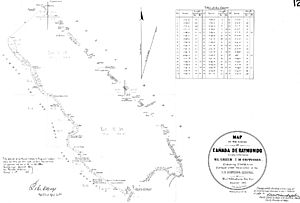Rancho Cañada de Raymundo facts for kids
Rancho Cañada de Raymundo was a huge piece of land, about 12,545 acres, given out as a Mexican land grant in what is now San Mateo County, California. This grant was first given on August 4, 1840, to a person named Raimundo. He was from Baja California and was sent by the priests of Mission Santa Clara in 1797 to find Mission Indians who had run away.
The valley where Laguna Creek flows was known as the Cañada de Raymundo on old maps from 1856 and 1868. Laguna Creek was also sometimes called Cañada Raimundo Creek. In 1841, the Rancho Cañada de Raymundo was officially granted to John Coppinger by Governor Juan Alvarado. This was a reward for Coppinger helping Alvarado in a rebellion against the Mexican leaders in Monterey.
The rancho was long and narrow, covering the eastern hills and valleys in today's Woodside area. It started at Alambique Creek, which was the northern edge of another rancho called Rancho Corte de Madera. It stretched north to Rancho Feliz. Rancho Cañada de Raymundo was bordered on the east by Rancho de las Pulgas. The rancho included a natural lake called Laguna Grande, which is now part of the Upper Crystal Springs Reservoir. This lake was a camping spot for the Portolà expedition on November 5, 1769. Laguna Creek flowed through the rancho and the lake, heading towards San Mateo Creek.
History of the Rancho
John Coppinger (1810–1847) was a lieutenant in the British Navy. He left his ship in San Francisco in 1835. He then worked for María Antonia Mesa, who was the widow of Rafael Soto, on another rancho. In 1839, Coppinger married María Luisa Soto (1817–1883), Rafael Soto's daughter.
As mentioned, Governor Alvarado gave Coppinger the Rancho Cañada de Raymundo in 1841. This was because Coppinger helped Alvarado in a revolt against the Mexican government in Monterey. During the Mexican-American War, the authorities wondered if Coppinger was still loyal. They took him to Mexico as a prisoner, but he was soon set free. He came back to California and stayed on his rancho until he passed away in 1847. His daughter, Manuela Coppinger (born in 1847), later married Antonio Miramontes.
After John Coppinger died, his wife, María Luisa Soto, moved back to her family's rancho. In 1849, an Irish sea captain named John Lucas Greer (1808–1885) arrived in San Francisco from South America. He explored San Francisco Bay in a small boat and sailed up San Francisquito Creek. In 1850, Greer and María Luisa Soto got married.
Greer and Soto moved to an adobe house on Rancho Cañada de Raymundo. They called their new home Greersburg. They started a business selling lumber and tallow (animal fat). Greer and Soto had three sons and two daughters together.
Land Ownership Changes
After the Mexican-American War, California became part of the United States. The Treaty of Guadalupe Hidalgo in 1848 said that the existing land grants would still be valid. So, in 1852, a claim for Rancho Cañada de Raymundo was filed with the Public Land Commission. This was a new rule from the Land Act of 1851. The land grant was officially approved and given to María Luisa Soto Coppinger Greer and Manuela Coppinger in 1859.
Over time, parts of the rancho were sold. In 1846, Charles Brown bought about 2,880 acres from Coppinger. Dennis Martin (who passed away in 1890) also bought about 1,400 acres from Coppinger.
There was a disagreement about the border between Rancho Cañada de Raymundo and the nearby Rancho de las Pulgas. A lawyer named Simon Monserrat Mezes, who owned a part of Rancho de las Pulgas, argued about where the line was. Even though the U.S. government had approved both ranchos, a survey in 1856 showed that their borders overlapped. It took a special law from the U.S. Congress in 1878 to finally fix this boundary problem.
Starting in 1852, the Spring Valley Water Company, which supplied water to San Francisco, began buying parts of Rancho Cañada de Raymundo. They put rules on these properties to protect the water sources. By 1861, Greer and María Luisa Soto found it hard to pay taxes on their land. In 1869, they moved back to the Rancho Rinconada del Arroyo de San Francisquito.


